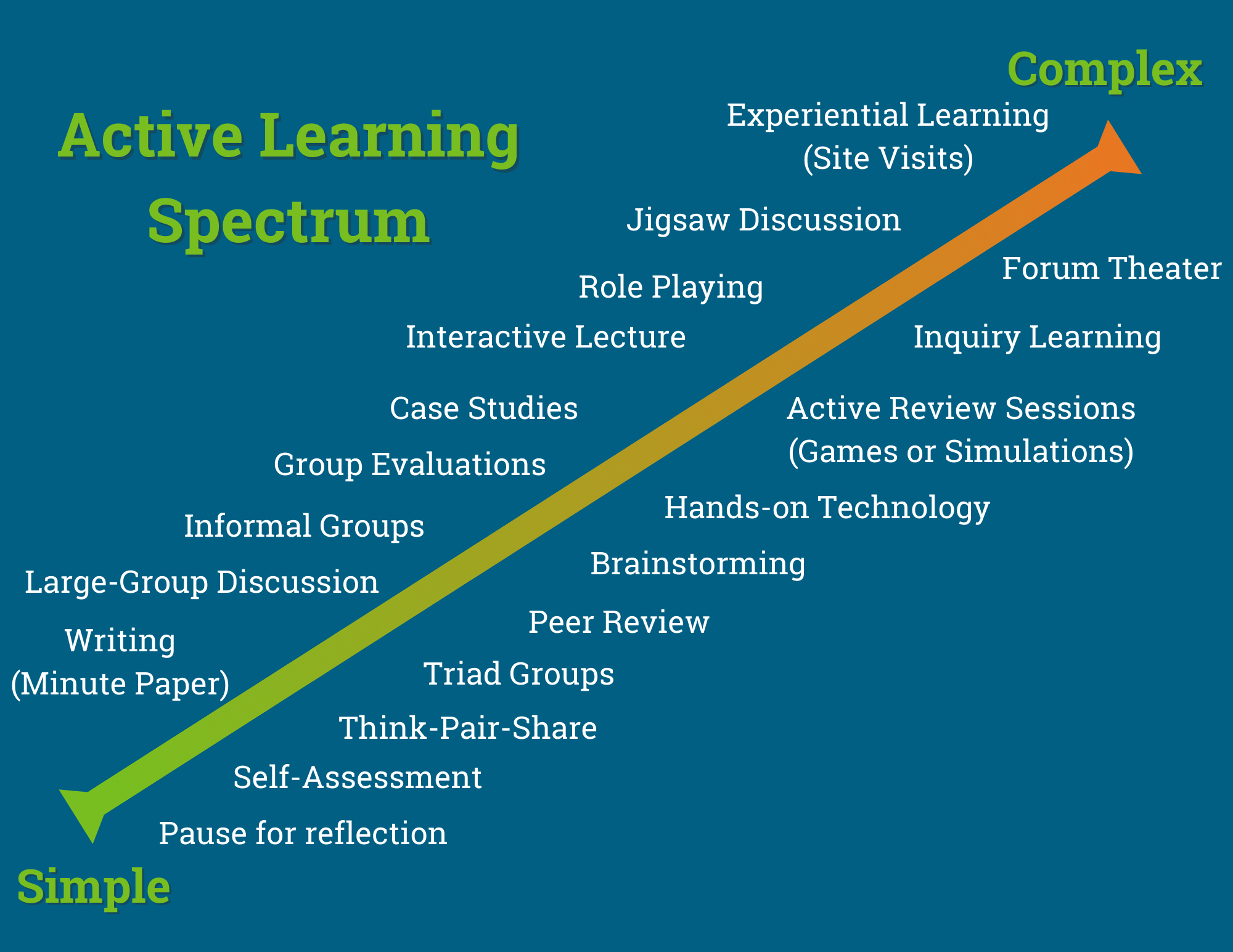Active Learning
The term active learning can be defined as "instructional activities involving students in doing things and thinking about what they are doing" (Bonwell and Eison, 1991). What does this mean? In practice, it often means that students are fully engaged in the learning process, particularly in the classroom. Instead of sitting in their seats passively listening to a lecture and maybe asking the occasional question, students are working together to solve problems, come up with ideas, apply concepts, discuss important issues, and much, much more. This can take place both in and out of the classroom.
Why engage in active learning? Well, as Richard Felder and Rebecca Brent point out in Teaching and Learning STEM: A Practical Guide (2016), "Hundreds of research studies and several meta-analyses of the research have shown that active learning outperforms traditional lecturing in promoting almost every learning outcome examined (Freeman et al., 2014; Prince, 2004; Wieman, 2014)."
This doesn't mean your class time should be nothing but activities. As with all teaching and learning strategies, it's about finding the right balance for you and your students. Maybe you lecture 1-2 days a week and then have a "free-for-all Friday" where students can come in and work on projects or homework assignments in the classroom. Maybe you start each class with a 10-minute activity to introduce them to the content. Or you end class with a 15-minute activity applying what they've learned.
There are LOTS of resources for active learning. We've provided several different options below, but don't be afraid to go looking for "active learning activities" in your favorite search engine. We in CAFE are also available for brainstorming various strategies. Feel free to schedule a consultation through the button below.

REFERENCES
Bonwell, C. C., and Eison, J.A. (1991). Active learning: creating excitement in the classroom. ASH#-ERIC Higher Education Report No. 1,
Bonwell, C. C., & Sutherland, T. E. (Eds.) (1996). Using active learning in college classes : a range of options for faculty. Jossey-Bass.
Felder, R., and Brent, R. (2016). Teaching and learning STEM: A practical guide. Jossey-Bass.
Freeman, S., Eddy, S.L., McDonough, M., Smith, M.K., Okoroafor, N., Jordt, H., & Wenderoth, M.P. (2014). Active learning increases student performance in science, engineering, and mathematics. Proceedings of the National Academy of Science, June 10, 204, Vol. 111, No. 23. Retrieved from www.pnas.org/content/early/2014/05/08/1319030111.full.pdf+html
Luks, C.P. (2013, June). Comparing a modified problem-based learning approach to a traditional approach to teaching heat transfer. Proceedings of the 120th ASEE Annual Conference and Exposition, Atlanta, GA, United States. https://scholarsmine.mst.edu/che_bioeng_facwork/687/
Mabrouk, P. A. (2007). Active learning : models from the analytical sciences. American Chemical Society.
Orsborn, S.D., & Hutcheson, R.S. (2014). Cued active learning: An initial study. Proceedings of the ASME 2014 International Design Engineering Technical Conference and Computers and Information in Engineering Conference, Buffalo, NY, United States. https://doi.org/10.1115/DETC2014-34234
Prince, M.J. (2004). Does active learning work? A review of the research. Journal of Engineering Education, 93(3), 223-231.
Schmidt, J.B., & Libre, N.A. (2020, June). Implementation and evaluation of active learning techniques: Adaptable activities for a variety of engineering courses [Conference session]. 2020 ASEE Virtual Annual Conference and Exposition. https://scholarsmine.mst.edu/mec_aereng_facwork/4590/
Spain, V. L. (2015). Instructional strategies used by developmental mathematics instructors in Missouri public community colleges to promote active learning : an analysis of the cognitive complexity (B. J. Dougherty (Ed.)). [University of Missouri--Columbia]. https://doi.org/10.32469/10355/47156
Wieman, C. (2014). Large-scale comparison of science teaching methods sends clear message. Proceedings of the National Academy of Sciences (PNAS), 111(23, 8319-8329. Retrieved from www.pnas.org/content/111/23/8319.full


Follow Center for Advancing Faculty Excellence